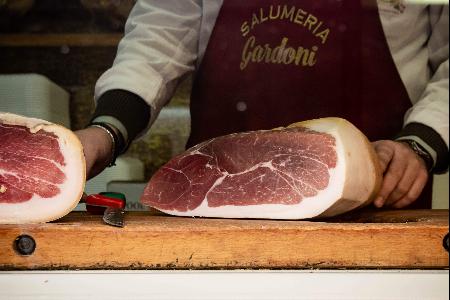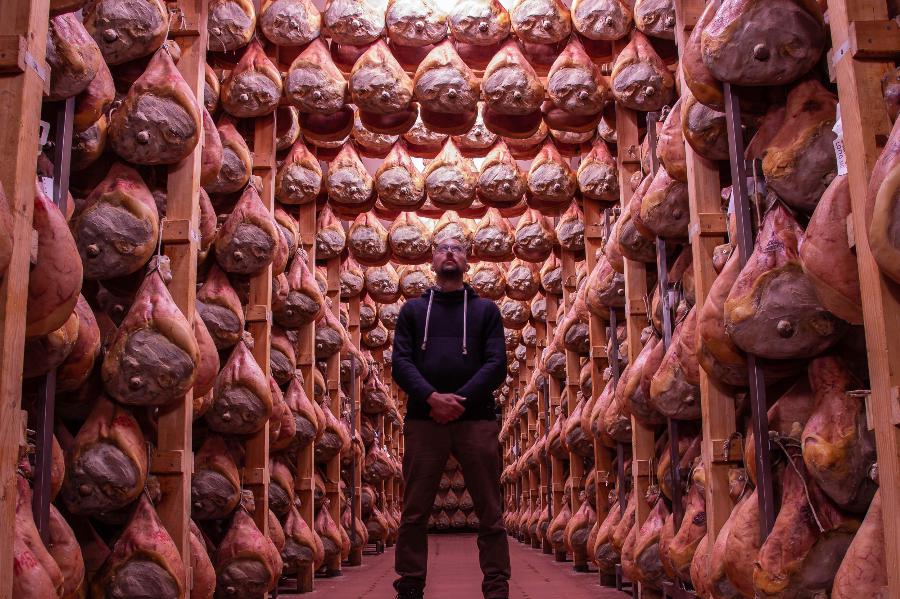When people first hear that traditional charcuterie meats like prosciutto or coppa can be made without nitrates, they’re often surprised. For anyone who enjoys cured meats but wants to understand exactly what’s in them, it helps to know how natural curing has worked for centuries — long before additives were even invented.
I’ve spent years studying, buying, and making nitrate-free and traditional nitrate-cured meats, experimenting with what creates the best balance of flavor, safety, and texture.
Through that process I’ve learned which types of charcuterie truly don’t contain nitrates, and which ones are simply marketed as “nitrate-free” but still rely on natural vegetable sources of nitrates such as celery or beetroot powder.
In short, true nitrate-free charcuterie depends on time, salt, and skill — not additives. Many regional Italian cured meats continue to follow these old-world methods, producing safe, flavorful results through careful drying and clean ingredients rather than chemical intervention.
Still, labels can be confusing. When a package says “no nitrates added,” that doesn’t necessarily mean there are none present.
The product may use naturally occurring nitrates from plant powders or extracts, which convert into the same nitrites once curing begins. This is why understanding how each meat is made matters much more than the words on the label.
As someone who both enjoys and produces cured meats, I sometimes use nitrates for longer-term projects like salami or traditional country ham. But for many whole-muscle dry-cured meats — especially those with strong regional traditions — salt and air alone do the job beautifully. That’s what this guide explores: the real nitrate-free classics and how they’re made.
Key Points
- Some Italian cured meats such as Parma Ham, Finocchiona, and Capocollo are traditionally made without added nitrates or nitrites.
- “Nitrate-free” or “no nitrates added” can still mean vegetable-based sources of nitrates are included.
- True artisanal charcuterie relies on salt, airflow, and temperature control rather than synthetic preservatives.
- Saltpetre and sodium nitrates have been used historically for consistency and safety, especially in large-scale commercial curing.

Whether you’re selecting meats for a charcuterie board or learning how to cure your own, understanding nitrates helps you make informed choices. The goal isn’t to fear them, but to know where they come from and when they’re actually necessary.
For example, the charcuterie greats from Italy — Prosciutto di Parma, Finocchiona, and Capocollo — are all protected by DOP standards that emphasize natural curing. These are salt-only processes governed by tight regulations, and the result is clean, layered flavor that speaks of the region it comes from.
In contrast, the modern “uncured” labels found in supermarkets often use vegetable powder nitrates to satisfy consumer demand for cleaner ingredients while keeping the same preservation chemistry. Knowing this distinction will save a lot of confusion when reading packaging or comparing products.
Traditional charcuterie is still a craft. From selecting the right cut of pork to balancing salt ratios and maintaining ideal humidity, artisans create preservation through natural chemistry rather than additives. It’s part of why these meats have remained safe and flavorful for hundreds of years. I’ve always admired that balance between simplicity and precision — it’s one of the reasons I began making my own cured meats at home.
So, before diving into specific examples of nitrate-free charcuterie, it’s worth first looking at how nitrates and nitrites actually function in curing. Once you understand their purpose — color stability, bacteria prevention, and longevity — it becomes clearer when they’re optional and when they’re essential. After that, you’ll see which traditional meats achieve the same results through time-tested natural methods.
Understanding Nitrates, Nitrites & Labels
Nitrates and nitrites are often treated as villains in processed food, but in the context of meat curing they serve a very specific role. Historically, people discovered that adding saltpeter (potassium nitrate) kept meats safe from dangerous bacteria like Clostridium botulinum. Over time, those compounds were refined into sodium nitrate and sodium nitrite for consistent dosing and reliable color preservation.
However, traditional dry-cured products that age slowly at controlled temperatures achieve safety through salt and moisture reduction alone. They don’t require chemical additions because the environment itself inhibits bacterial growth. These are the meats that can genuinely be described as nitrate-free in the truest sense.
The challenge today is labeling. Terms like “no nitrates added” and “uncured” are regulated differently across countries. In many places, producers can use celery or beet extracts as natural curing agents yet still promote the product as nitrate-free. This has led to confusion among consumers who are simply trying to avoid synthetic additives.
In the sections that follow, I’ll break down some of the best-known nitrate-free cured meats — explaining how they’re made, what gives them their distinct flavor, and how to choose quality examples for your next charcuterie board.
Types of Charcuterie Meats Without Nitrates or Nitrites
Among the countless regional specialties across Europe, several famous cured meats stand out for being traditionally made without nitrates or nitrites. These classic products depend solely on salt, airflow, and patience to create their distinctive flavor and texture.
Below are three examples that showcase how natural methods have endured for generations — and why these remain benchmarks for authentic charcuterie.
Parma Ham (Prosciutto di Parma DOP)

Prosciutto di Parma DOP is one of Italy’s proudest culinary exports and perhaps the best-known naturally nitrate-free cured meat. Its strict production code allows only two ingredients — pork and salt — and requires at least twelve months of aging under specific temperature and humidity conditions in the Parma region.
The process begins with selected hind legs from pigs raised in eleven approved Italian regions. Each leg is salted by hand, rested, washed, and slowly dried in temperature-controlled rooms that take advantage of the region’s natural breezes. Nothing else is added; the environment does the work.
This long maturation draws out moisture and intensifies natural sweetness. The result is tender, aromatic ham with nutty, slightly floral notes — a flavour impossible to fake with additives. Real Parma is instantly recognisable for its crown brand and gentle salt balance.
Enjoy thin slices with fresh fruit, mozzarella, or warm bread. Its subtle sweetness also pairs beautifully with sparkling wines or crisp prosecco. As one Italian producer told me, “Parma Ham needs nothing added — only time and respect.”
To understand more about why some meats include nitrates while others don’t, I’ve written a full breakdown in Cured Meat & Nitrates (Research Summary) — it explains how nitrates work chemically and when they’re optional.
Finocchiona (Tuscan Fennel Salami)
Originating in Tuscany, Finocchiona is a DOP-protected dry-cured salami seasoned generously with wild fennel seed. It’s believed that a thief once dropped fennel into stolen salami to disguise the smell — the flavour was so good that it became tradition.
True Finocchiona is made with coarsely ground pork, salt, black pepper, garlic, and fennel, then aged slowly in cool Tuscan air. Many artisan versions skip added nitrates entirely, relying instead on salt and controlled fermentation to safely preserve the meat.
The result is a delicately perfumed salami with a soft texture and rich, savoury aroma. Pair it with Montasio or Pecorino Toscano, roasted red peppers, and olive-oil crackers for a balanced charcuterie plate. If you appreciate the layered taste of natural seasoning, Finocchiona deserves a permanent place on your board.
To explore how ingredients like salt, sugar, and natural herbs influence curing outcomes, see Main Ingredients for Curing Meat — it outlines how each component shapes preservation and flavour.

Capocollo (Coppa)

Capocollo, sometimes called Coppa, is produced from the muscle running from a pig’s neck to its fourth rib. The meat is seasoned with salt and a subtle mix of herbs before being encased and aged. Traditional southern Italian versions, like Calabrian Capocollo, may include chilli or sweet paprika for heat and colour.
Because the cut is marbled but lean, Capocollo develops a silky mouthfeel once cured. The flavour is delicate rather than assertive, which makes it ideal alongside stronger condiments like olives or a garlicky spread. I often slice it thin and layer it with mild cheese or fruit on a charcuterie board.
While modern producers sometimes use curing salts for consistency, many small Italian and European artisans still craft Capocollo without nitrates, relying on pure salt and slow drying to achieve the same preservation effect.
If you ever have leftover slices, they keep well when wrapped tightly and refrigerated. I cover some practical storage ideas in What to Do with Charcuterie Meat Leftovers.
These three examples highlight how centuries of tradition can replace chemical shortcuts. By maintaining precise humidity and temperature conditions, producers preserve meat safely while developing flavour complexity impossible to replicate in faster, additive-based methods.
When making or buying charcuterie, remember that terms like “uncured” or “nitrate-free” vary by region. Reading ingredient lists — and learning about techniques behind them — tells you more than any marketing claim. For a deeper dive into comparing traditional salt curing and brine-based techniques, check out Dry Curing vs Wet Brining for Meat Curing.
Next, we’ll look at saltpetre and modern sodium nitrates — why they still exist in commercial meat curing, and how they differ from these natural, additive-free traditions.
Saltpetre and Modern Sodium Nitrates
Saltpetre, or potassium nitrate, was one of the earliest curing agents ever used. For centuries, it helped prevent spoilage and kept meats like ham and salami safe to eat. When rubbed into meat, saltpetre slowly breaks down into nitrite, which inhibits bacteria such as Clostridium botulinum — a serious concern in improperly cured products.
In more recent times, sodium nitrate and sodium nitrite replaced traditional saltpetre because they’re easier to measure and act faster. They became essential for mass production, where efficiency and shelf stability were priorities. However, for small-scale or artisan curing, many producers still prefer the slower, more natural salt-only approach.
These modern additives often get an unfair reputation. They are not inherently harmful when used in tiny, controlled quantities, but for naturally cured meats like Prosciutto di Parma or Capocollo, they’re simply unnecessary. Long drying times, strict hygiene, and carefully monitored humidity are enough to create safe, complex flavors.
It’s important to note that some charcuterie labeled “uncured” in the United States or other regions may still use natural nitrate sources, such as beetroot or celery powder. These plant-based compounds convert to nitrite in the same way as synthetic curing salts. The difference lies mainly in the source and marketing — not the final chemistry.
If you’re interested in understanding the chemistry behind these ingredients and their role in color, flavor, and safety, I cover the fundamentals of both curing salts and natural alternatives in Main Ingredients for Curing Meat. It’s a good place to explore why salt alone can still deliver authentic results when used with proper control.
Making Nitrate-Free Charcuterie at Home
One of the most rewarding ways to appreciate nitrate-free curing is to make it yourself. With the right setup, temperature control, and patience, home curing can produce results that rival high-end delicatessens. You don’t need expensive tools, but precision matters — especially in managing salt ratios and humidity.
Start with a whole-muscle cut like pork loin, belly, or beef eye of round. Use quality sea salt and simple spices like cracked pepper or garlic. Avoid iodized or table salts that can cause off-flavors. Once the meat is salted and rested, hang it in an environment around 12–15°C (50–59°F) with 70–80% relative humidity.
Within a few weeks or months, depending on thickness, you’ll notice the surface drying and the aroma transforming. That slow evolution is what makes nitrate-free charcuterie so special — pure preservation through salt, air, and time.
To explore the full process from start to finish, including safety, setup, and ideal curing conditions, see my detailed Guide to Curing Meat at Home. It explains every stage with clear steps and images.
Even if you decide not to make your own, understanding how nitrate-free charcuterie is made gives you a deeper appreciation for the craftsmanship behind every slice on your board. It’s a reminder that minimal ingredients and patience often produce the most honest flavors.
Expert Tip
Read ingredient labels carefully. “No nitrates added” doesn’t always mean additive-free. Check whether vegetable powders or extracts appear in the list — those contain naturally occurring nitrates. When in doubt, look for DOP or IGP designations, which often guarantee traditional salt-only curing. Choosing certified regional products supports heritage producers who keep nitrate-free craftsmanship alive.
Frequently Asked Questions
Is Prosciutto di Parma nitrate-free?
Yes. True Prosciutto di Parma DOP contains only pork and salt — no nitrates or nitrites are added. Its safety and flavor come from slow aging and carefully controlled drying conditions.
What does ‘nitrate-free’ really mean on meat labels?
It usually means no synthetic nitrates were added. However, the product may still include natural sources like celery or beetroot powder, which act the same way during curing.
Are nitrates dangerous in cured meat?
Not when used correctly. In small, regulated amounts, nitrates prevent harmful bacteria like botulism. The key difference lies between traditional artisan curing (often nitrate-free) and industrial methods that use additives for consistency.
Can I make nitrate-free charcuterie at home safely?
Yes — as long as you maintain proper salt ratios, temperature, and humidity. Salt and time alone can preserve meat naturally when handled with care. See my complete illustrated guide for full steps.
Have a question or your own experience with nitrate-free charcuterie? Leave a comment below — I’d love to hear what you’ve discovered or made at home.

Tom Mueller
For decades, immersed in studying, working, learning, and teaching the craft of meat curing, sharing the passion and showcasing the world of charcuterie and smoked meat. Read More

Thanks for this great article! I have found out that nitrates/nitrites cause terrible migraines for me. So I am looking for alternatives to bacon, deli meats, etc. This was very informative.
Thanks for the thanks! Yeah I am getting away from that stuff more and more with my home made charcuterie too! Cheers Tom
I would like to say education with an emphasis on factual statistics and not rhetorical propaganda goes a long way to stop the spread of misinformation and to that, I say Bravo … any salt in great amounts can be very detrimental to overall health and as to that seeing that botulism is the most toxic organic substance on the earth 30 nanograms can kill a person that is 30 parts per billion very very small dose still very deadly .. my point is proper minimum amounts of nitrates coupled with healthy bacteria can make salami … ect… completely healthy to eat the real problem is if a person tastes their product before it gets a chance to do its job the chance of cancer increases to an alarming rate the key is to taste your product for seasoning adjustments before you add the extremely small amount of sodium nitrates it will get a chance t to bind with the protein and then through the long duration of time it takes for meats that are encased in natural or collagen casing will be completely free of not just botulism but any toxic bacteria that can harm the human digestive system including Listeria that will happen once the minimu time had elapsed .. it is this process that will quell the S.J.W’S or Social Justice Warriors having any kind of factual amunition to use in thier misinformation spreading campaign .. any person with a brain and acess to the net can figure out how to read between the lines if you want to find out more about the proper use and when not to use not just sodium nitrate but many other food additives just go to the websiite “2 guys and a cooler” they have about 300 how videos to make safe to eat cured meats like ham and all its vvaritations to the proper bacterial culture to add to said products that are in a casing and why .. anyways I hoipe to see more of your stuff
Thanks for taking the time to write! Agreed!